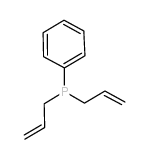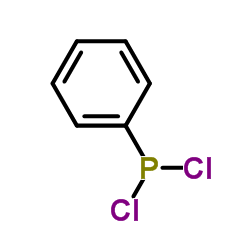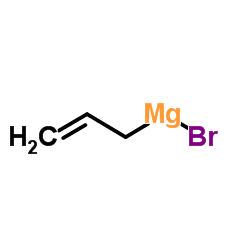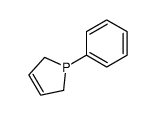diallylphenylphosphine
Modify Date: 2024-01-03 07:58:55

diallylphenylphosphine structure
|
Common Name | diallylphenylphosphine | ||
|---|---|---|---|---|
| CAS Number | 29949-75-5 | Molecular Weight | 190.22100 | |
| Density | 0.969 g/mL at 25ºC(lit.) | Boiling Point | 127ºC14 mm Hg(lit.) | |
| Molecular Formula | C12H15P | Melting Point | N/A | |
| MSDS | N/A | Flash Point | 112.4ºC | |
| Name | phenyl-bis(prop-2-enyl)phosphane |
|---|---|
| Synonym | More Synonyms |
| Density | 0.969 g/mL at 25ºC(lit.) |
|---|---|
| Boiling Point | 127ºC14 mm Hg(lit.) |
| Molecular Formula | C12H15P |
| Molecular Weight | 190.22100 |
| Flash Point | 112.4ºC |
| Exact Mass | 190.09100 |
| PSA | 13.59000 |
| LogP | 3.16580 |
| Vapour Pressure | 0.0246mmHg at 25°C |
| Index of Refraction | n20/D 1.568(lit.) |
| Storage condition | Flammables area |
Synonym: Section 2 - COMPOSITION, INFORMATION ON INGREDIENTS
Risk Phrases: 17 36/37/38 Section 3 - HAZARDS IDENTIFICATION EMERGENCY OVERVIEW
Spontaneously flammable in air. Irritating to eyes, respiratory system and skin.Air sensitive. Potential Health Effects Eye: Causes eye irritation. Skin: Causes skin irritation. May be harmful if absorbed through the skin. Ingestion: May cause irritation of the digestive tract. May be harmful if swallowed. Inhalation: Causes respiratory tract irritation. May be harmful if inhaled. Chronic: Not available. Section 4 - FIRST AID MEASURES Eyes: Flush eyes with plenty of water for at least 15 minutes, occasionally lifting the upper and lower eyelids. Get medical aid. Skin: Get medical aid. Flush skin with plenty of water for at least 15 minutes while removing contaminated clothing and shoes. Ingestion: Get medical aid. Wash mouth out with water. Inhalation: Remove from exposure and move to fresh air immediately. If not breathing, give artificial respiration. If breathing is difficult, give oxygen. Get medical aid. Notes to Physician: Treat symptomatically and supportively. Section 5 - FIRE FIGHTING MEASURES General Information: As in any fire, wear a self-contained breathing apparatus in pressure-demand, MSHA/NIOSH (approved or equivalent), and full protective gear. Material can spontaneously ignite (pyrophoric) when exposed to air at normal or slightly elevated temperatures. Extinguishing Media: Use water spray, dry chemical, carbon dioxide, or chemical foam. Section 6 - ACCIDENTAL RELEASE MEASURES General Information: Use proper personal protective equipment as indicated in Section 8. Spills/Leaks: Absorb spill with inert material (e.g. vermiculite, sand or earth), then place in suitable container. Remove all sources of ignition. Use a spark-proof tool. Section 7 - HANDLING and STORAGE Handling: Use spark-proof tools and explosion proof equipment. Avoid breathing dust, vapor, mist, or gas. Avoid contact with skin and eyes. Use and store under nitrogen. Use only in a chemical fume hood. Storage: Keep away from sources of ignition. Do not store near combustible materials. Store in a cool, dry place. Store in a tightly closed container. Flammables-area. Store under nitrogen. Section 8 - EXPOSURE CONTROLS, PERSONAL PROTECTION Engineering Controls: Facilities storing or utilizing this material should be equipped with an eyewash facility and a safety shower. Use adequate ventilation to keep airborne concentrations low. Exposure Limits CAS# 29949-75-5: Personal Protective Equipment Eyes: Not available. Skin: Wear appropriate protective gloves to prevent skin exposure. Clothing: Wear appropriate protective clothing to prevent skin exposure. Respirators: Follow the OSHA respirator regulations found in 29 CFR 1910.134 or European Standard EN 149. Use a NIOSH/MSHA or European Standard EN 149 approved respirator if exposure limits are exceeded or if irritation or other symptoms are experienced. Section 9 - PHYSICAL AND CHEMICAL PROPERTIES Physical State: Liquid Color: colorless Odor: Not available. pH: Not available. Vapor Pressure: Not available. Viscosity: Not available. Boiling Point: 127 deg C @ 14 mmHg Freezing/Melting Point: Not available. Autoignition Temperature: Not available. Flash Point: Not available. Explosion Limits, lower: Not available. Explosion Limits, upper: Not available. Decomposition Temperature: Solubility in water: Specific Gravity/Density: .9690g/cm3 Molecular Formula: C12H15P Molecular Weight: 190.23 Section 10 - STABILITY AND REACTIVITY Chemical Stability: Not available. Conditions to Avoid: Incompatible materials, ignition sources, exposure to air. Incompatibilities with Other Materials: Strong oxidizing agents. Hazardous Decomposition Products: Carbon monoxide, oxides of phosphorus, carbon dioxide. Hazardous Polymerization: Has not been reported Section 11 - TOXICOLOGICAL INFORMATION RTECS#: CAS# 29949-75-5 unlisted. LD50/LC50: Not available. Carcinogenicity: Diallylphenylphosphine - Not listed by ACGIH, IARC, or NTP. Section 12 - ECOLOGICAL INFORMATION Section 13 - DISPOSAL CONSIDERATIONS Dispose of in a manner consistent with federal, state, and local regulations. Section 14 - TRANSPORT INFORMATION IATA Shipping Name: PYROPHORIC LIQUID, ORGANIC, N.O.S.* Hazard Class: 4.2 UN Number: 2845 Packing Group: I IMO Shipping Name: PYROPHORIC LIQUID, ORGANIC, N.O.S. Hazard Class: 4.2 UN Number: 2845 Packing Group: I RID/ADR Shipping Name: PYROPHORIC LIQUID, ORGANIC, N.O.S. Hazard Class: 4.2 UN Number: 2845 Packing group: I Section 15 - REGULATORY INFORMATION European/International Regulations European Labeling in Accordance with EC Directives Hazard Symbols: XI F Risk Phrases: R 17 Spontaneously flammable in air. R 36/37/38 Irritating to eyes, respiratory system and skin. Safety Phrases: S 26 In case of contact with eyes, rinse immediately with plenty of water and seek medical advice. S 37/39 Wear suitable gloves and eye/face protection. WGK (Water Danger/Protection) CAS# 29949-75-5: No information available. Canada None of the chemicals in this product are listed on the DSL/NDSL list. CAS# 29949-75-5 is not listed on Canada's Ingredient Disclosure List. US FEDERAL TSCA CAS# 29949-75-5 is not listed on the TSCA inventory. It is for research and development use only. SECTION 16 - ADDITIONAL INFORMATION N/A |
| Hazard Codes | F: Flammable;Xi: Irritant; |
|---|---|
| Risk Phrases | R17 |
| Safety Phrases | 16-26-27-28-36/37/39-37/39 |
| RIDADR | UN 2845 4.2/PG 1 |
| WGK Germany | 3 |
| Packaging Group | I |
| Hazard Class | 4.2 |
|
~% 
diallylphenylph... CAS#:29949-75-5 |
| Literature: Journal of the Chemical Society, , p. 1446,1449 |
|
~% 
diallylphenylph... CAS#:29949-75-5 |
| Literature: Journal of Organometallic Chemistry, , vol. 301, p. 289 - 298 |
| diallyl-phenyl-phosphine |
| bis-allylnphenylphosphine |
| MFCD00014955 |
| diallylphenyl phosphane |
| phenyldiallylphosphin |


![Phenylphosphonous acid bis[(1R,2S,5R)-5β-methyl-2α-(1-methylethyl)cyclohexyl] ester structure](https://www.chemsrc.com/caspic/260/58359-50-5.png)

 CAS#:28278-54-8
CAS#:28278-54-8 CAS#:54509-73-8
CAS#:54509-73-8